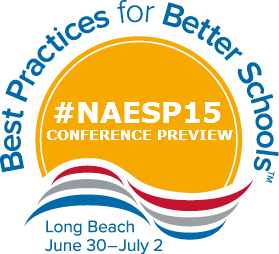On the Growing Diversity in Schools
Communicator May 2015, Volume 38, Issue 9
Communicator
May 2015, Volume 38, Issue 9
 Instruction for English-language learners (ELLs) is more important than ever, especially as school demographics continue to shift. “Minority majorities,” Latino test scores as compared to other cohorts, and what it all signifies for educators are some of the issues that Yvette Donado, senior vice president and chief administrative officer of the Educational Testing Service (ETS), will address at this year’s NAESP Annual Conference in Long Beach, California. Here’s a preview of her message.
Instruction for English-language learners (ELLs) is more important than ever, especially as school demographics continue to shift. “Minority majorities,” Latino test scores as compared to other cohorts, and what it all signifies for educators are some of the issues that Yvette Donado, senior vice president and chief administrative officer of the Educational Testing Service (ETS), will address at this year’s NAESP Annual Conference in Long Beach, California. Here’s a preview of her message.
Q: Can you provide an overview of how our schools are changing demographically?
A: By 2025, our population will be majority minority. California is a witness to such changes. For example, the percentage of registered Latino voters in California nearly doubled between 2000 and 2012, from 13.9 percent to 26 percent.
There are about 6 million ELLs in our public schools alone, and about 80 percent are Spanish speakers. They are the fastest growing segment in our elementary schools—and they are not all immigrants or children of immigrants. Many come from communities that are marginated, where Spanish is the language of the home, the playground, and the community. We need to better understand the realities of such learners and their communities.
Q: How can this change be viewed as both a challenge and an opportunity?
A: Unlike other countries, we have a school system for every state, commonwealth, and territory. So it is up to each not only to recognize the shifts, but also anticipate them, prepare for them, and execute policies to address them. Smart systems will do that. I gave a speech in Brazil recently in which I pointed out that American companies can no longer poach talent from other companies or from abroad. They must develop from within and in their own neighborhoods. Silicon Valley high-tech companies, for example, are reaching into high schools to tap talent.
Now, the challenge is to find new, creative ways to ensure that the emerging cohorts in our schools have a “college-bound culture” in the home, and that they stay in school and aspire to higher education. The jobs are there; the opportunities are there. It’s about preparing for and seizing the opportunity.
Q: What are some misconceptions that educators have about ELL education?
A: The misconceptions are many. First, some believe that a person who does not speak English well is a slow learner, or worse. This can have disastrous consequences. Second, some believe that non-native speakers of English cannot adjust socially. Research shows that speakers of more than one language adjust socially better than their monolingual peers. And third, some believe that putting ELLs into special classes is the solution.
ETS has done years of research into these and other realities. And the misconceptions are just that. Let me explain. As for [the misconceptions about] slow learners, these kids are just as bright as the next student. They may know math or geography in their language, but cannot adequately convey knowledge in English.
Research shows, furthermore, that a good grounding in a native language makes it easier to acquire a second language. Unfortunately, ELLs are pressured to abandon their native tongues in favor of mastering English.
Q: Are there steps that every educator, particularly principals, can take—other than training—that can improve their ELL practice?
A: Yes, of course. First, principals and other educators can ensure that their schools provide a welcoming environment to parents of ELLs. Parents are often immigrants and in the Spanish-speaking world, many believe that education happens only in the school. The reality is that learning happens in the family, the smallest school. So parents must gain a better understanding of what happens in the school, what a counselor does, what a PTA is.
Many cannot attend a Thursday afternoon PTA meeting, because they are working their second or third job and might have to take three buses to get there, for example. Schools should be flexible, and perhaps offer Saturday morning programs.
Schools can also turn to volunteers for help. It could be a graduate student at a local university, a retired person who is well-versed in cross-cultural communication, or a local organization that shares an interest in a strong start for ELLs and learners in general.
Donado will deliver a special presentation, “Growing Diversity in Schools: Challenges and Opportunities,” NAESP’s 2015 Best Practices for Better Schools conference in Long Beach, California. Click here for more information and to register.
—
Copyright © 2015. National Association of Elementary School Principals. No part of the articles in NAESP magazines, newsletters, or website may be reproduced in any medium without the permission of the National Association of Elementary School Principals. For more information, view NAESP’s reprint policy.


